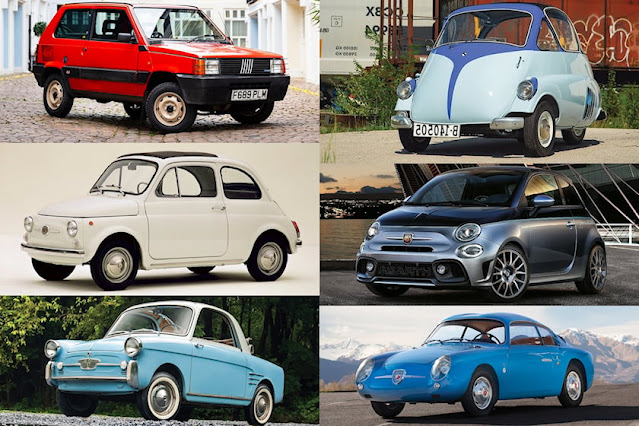6 Tiny Italian Cars History Shouldn't Forget
All but one have at least a flavor of Fiat.
If you play the stereotypes game with cars, the first thing that comes to mind with Italy is exotic supercars. That's not a surprise as the general consensus is that the first supercar was a Lamborghini and Ferrari is the brand associated most with style and performance in popular culture. However, most Italians aren't rolling around in Lamborghinis, Ferraris, or Maseratis. They're mostly rolling around in small yet stylish city cars. After all, if there's one stereotype that's a stereotype for a reason with Italy, it's style. The best-selling car in Italy right now is the little Fiat Panda, followed by another small Fiat. Couple that with a long history of tiny Italian cars, admittedly mainly by Fiat, and you have a list we're rubbing our hands with glee to put together.
Fiat 500
The classic, original Fiat 500 is a marvel in so many ways. While the first Fiat 500 (Topolino) was the car that lit Italy's economic regrowth after World War I and got Italians on the road, the successor, launched in 1957, became an instant icon and the 500 everybody knows and loves. It became as ubiquitous as the Volkswagen Beetle and the original Mini. Like the German Beetle and the French Citroen 2CV, the Fiat 500 was one of the earliest mass-market "people's cars" and became the symbol of a generation of mobility. The 500 name comes from its rear-mounted base 500cc two-cylinder engine, which allowed the cabin to feel a lot bigger inside than you would assume from the outside. The first engines made just 13 horsepower; later, Abarth 500 models made 27 to 38 hp.
Fiat-Abarth 750
Abarth was founded in 1949 by Carlo Abarth and was mainly known for performance parts for small Italian cars and Fiat-based race cars, like the 750. It was based on the Fiat 600, just after the 600 was launched in 1955. The 710 cc engine was the more powerful option and made 39 hp as it revved out to 6,900 rpm. It weighed just 1,200 pounds. The most collectible version is the Zagato-designed "double bubble" bodywork version. A more restrained 750 Zagato model had a luxury version called America designed for export to, as the name suggests, North America. Power for Zagato-bodied models raised to 42 hp.
Iso Isetta
The Isetta is better known with a BMW badge, but that's because Iso Autoveicoli made the smart move of licensing the hell out of the Isetta. The Isetta is the definitive little Italian car. It led to other "bubble cars," but the Isetta was the best seller, with 161,728 built over the eight years it was in production. The Isetta was born for the same reason as the Fiat 500: Italy needed inexpensive transport after World War II, and the bubble car was as cheap as it got to buy and run with its single-cylinder motorbike engine. Amazingly, three were entered into the legendary Mille Miglia race in 1954, and over the 1,000-mile course, all three finished in the top three of the economy class.
Fiat Panda 4x4
In the 1980s, the Fiat Panda was subject to one of the most Italian design decisions in history. The original brief was that it should have a spacious and spartan interior while weighing and costing no more than the Fiat 126. It was to be an egalitarian car, and the design was handed over to the company Giugiaro and Mantovani. Giugiaro came to the conclusion that the Panda should be able to fit two 50-liter demijohns of wine as well as a full complement of passengers. The Panda was an instant success, and its robust, rugged simplicity was expanded upon with a four-wheel-drive model in 1983, making it the first small, transverse-engined production car with an all-wheel-drive system. It was designed for adverse conditions on farmland and countryside dirt tracks, with the system being manually selectable and having an extra-low first gear. The Panda 4x4 never made it to America, which is a shame.
Autobianchi Bianchina Trasformabile
Fiat was, and still is, a powerhouse in Italy; hence another car makes this list with the brand's name attached. Autobianchi was a small Italian car manufacturer founded by Fiat, Pirelli, and Bianchi, lasting from 1955 until it went out of business in 1995. The Autobianchi Bianchina was a small Italian car based on the Fiat 500 and available in different body styles, including a sedan, roadster, wagon, and fixed-profile convertible. The Bianchina Trasformabile was the latter, and took o the form of an oddball model that appeared in 1957 with a bicolor paint job; an engine uprated to make 20 horsepower, a partially convertible roof, and, of all things, suicide doors.
Abarth 695 Biposto
The modern Fiat 500 Abarth is feeling its age now, but it's still a blast to drive if outright speed isn't all that matters to you. Fiat bought Abarth in 1971; since then, it has been the in-house performance brand for the automaker, even dabbling in the realm of performance EVs recently. The Abarth 695 Biposto appeared in 2015 with some serious weight loss signified by only having two seats (biposto translates as such). It also featured a titanium rear strut brace, Brembo brakes, OZ wheels, adjustable suspension, and the option for polycarbonate windows and a race-style shift lever. It was stupidly expensive with the options added, more than doubling the price of a regular Fiat 500, but so much fun to drive.
Thanks to CARBUZZ for providing us with this free information so we can find out what we don't know.







0 Response to "6 Tiny Italian Cars History Shouldn't Forget"
Post a Comment